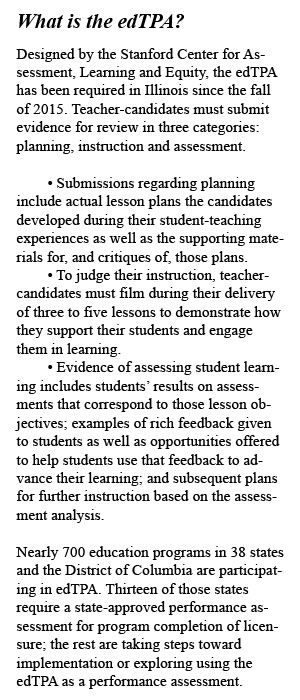
Laura Tuma felt uneasy when she first heard about the edTPA, the new assessment she would need to pass before receiving teacher licensure in Illinois.
“It was very intimidating at first. It was very scary not knowing what to expect,” says the recent graduate of the Department of Kinesiology and Physical Education. “It was new to our professors, too, so that almost made us more intimidated. If they didn’t know a whole lot about it, how were we going to be prepared?”
With nurturing guidance from her professors, Tuma passed her edTPA – as did 100 percent of undergraduates in the NIU College of Education who submitted their materials in the spring of 2016.
The College of Education’s most recent numbers are well ahead of the state and national results. The college’s teacher-candidates scored higher than the national average in all but one rubric, where they tied, and higher than or equal to the state average in all rubrics.
“My professors took the bull by the horns and were able to break it down, step by step,” Tuma says. “They integrated chunks of the edTPA into all of our classes.”
Most students are “nervous at first” about the edTPA, confirms Jennifer Johnson, director of teacher preparation and development in the NIU College of Education.
“The edTPA is a high-stakes assessment that could impact your ability to get a teacher’s license. It mandates that all teachers will be highly qualified,” she says. “Attorneys, doctors and accountants have mandated licensure exams, and the addition of the edTPA adds that level of professional accountability to our field.”

For NIU, of course, the production of highly qualified teachers is a tradition.
“Our students were so successful on the edTPA because our faculty took a vested interest in supporting them,” she says. “The students practice these skills during multiple semesters, and we will continue to do that. We will keep working.”
Johnson is confident NIU’s success will endure even while the score required for passage continues to rise over the next few years. “The students in our program will receive edTPA preparation all the way through.”
Anne Gregory, chair of the Department of Literacy and Elementary Education, says College of Education teacher-education students hear “a constant message throughout their course of study” on the importance of edTPA preparation.
Meanwhile, Gregory adds, COE faculty clearly identify aspects of coursework activities and assignments “that mirror or, with a few tweaks, could better mirror the edTPA.”
Students are encouraged to set realistic goals in their preparation, to “break the tasks into manageable chunks” and to attend workshops coordinated through NIU’s Office of Educator Licensure and Preparation.
Preparing for the edTPA enables them to identify instructional needs, to study those in their NIU classrooms, to model them in student-teaching and then, Gregory says, “look to see if their students grow as well. It’s what good teachers do naturally as they gain some experience, and it’s a preview of what they will do consistently.”
Feeling edTPA stress is normal – “With any kind of licensure demand, or anything high-stakes, there’s a lot of pressure,” she says – but that anxiety soon evaporates.
“Just by getting their feet into a classroom space on ‘the other side,’ then there’s no longer that fear of the unknown,” Gregory says. “It becomes, ‘Oh, I can do this!’ ”

Tuma, the newly minted alumna who now teaches physical education in suburban Yorkville at an elementary school and an intermediate school, is witnessing the value of the edTPA in her daily work.
During every-Wednesday staff meetings with her colleagues from all disciplines, collaborative discussions often focus on assessment.
“That’s what the edTPA was all about – assessments, and what you are going to do with those,” Tuma says. “That’s huge at my school. They want to see data. They want to know numbers. They want to see the success in our students, and that they’re learning.”
For teachers, she says, it means looking beyond the levels of comprehension or mastery shown through testing.
She cites as an example her own edTPA submission from her student-teaching time in nearby Rochelle, where she filmed a unit on basketball skills.
Her submission included her instruction on how to make a layup, video of the students attempting layups, peer observation and paperwork where students reported their numbers of successful layups.
That exercise – something simply required for licensure – now lives and breathes every day inside her gym in Yorkville.
If a student completes five of 10 layups in a basketball unit, what does that tell the P.E. teacher? Is five good enough? If not, why aren’t they making more shots? If no one is making more than five, what does that say about the instruction?
“I always flash back to the edTPA,” Tuma says. “It’s easy to give students a worksheet, or to tell them to do something, but it’s important what teachers take away from that assessment they gave. A teacher needs to reflect on that.”
Her alma mater Department of Kinesiology and Physical Education began piloting some of the edTPA templates in spring 2015 in advance of the fall 2015 implementation, says Jim Ressler, associate professor of physical education teacher education.
“As a program, we made the decision modify our lesson plan template to reflect language used by the edTPA, and we’ve found ways to integrate its components into our methods classes and most of our practicums,” he says.

Physical education teachers historically have organized their content around themes – skills, for example – and then plan related instructional units that might span several weeks.
Regardless of the specific daily tasks is “the domain” – psychomotor, cognitive and affective – into which physical education teachers buoy each lesson.
“All three domains are commonly in play,” Ressler says. “Our students have been trained to do this quite well planning for, and assessing, all three simultaneously.”
But “the edTPA is concerned with your ability to put together three to five lessons in succession that are coherent and that align toward a single, central focus. That central focus is the aim from the first or second minute of the first lesson to the final five minutes of the last lesson,” he says. “That’s been quite a shift for our students.”
However, he and his colleagues in KNPE see benefits to the edTPA’s philosophy and have made it “just one part of the overall process of becoming highly effective teachers after leaving our program.”
“The minds of teacher-candidates are always on the big idea, the real role of planning and how important it is to have adequate preparation to deliver lessons,” he says. “They also need ways to back up their actions of putting lesson plans together in advance, trying to teach them well and having clear systems in place to make sure the lessons went as well as they thought they did. If the lesson didn’t go well, can you reflect on why – and suggest changes?”

